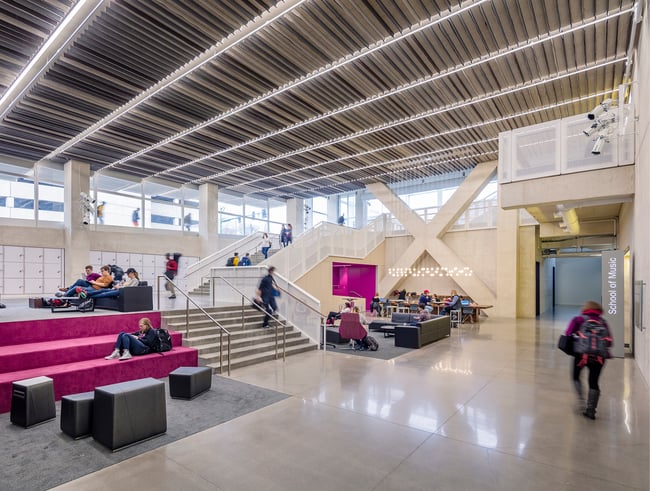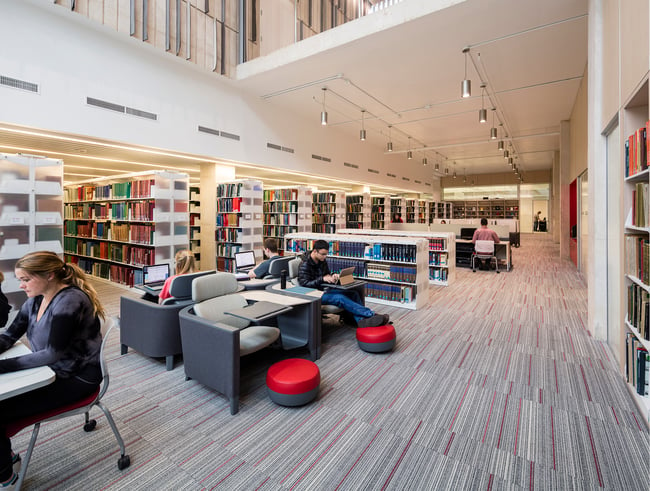Challenges in Higher Education and How Architects Can Help

The Covid-19 pandemic impacted everyone, and today many industries and institutions still feel its effects. University campuses are one place where these effects are particularly pronounced.
From declining enrollment to new student needs, universities are facing more challenges than ever. While some challenges are institutional, campus planning and building design can address others.
At Neumann Monson, we work with clients across multiple sectors. We have seen many industries work to reinvigorate their mission after the pandemic and know these lessons can apply to higher education.
This article will discuss the top challenges facing higher education in 2022 and how architects can help address them.
4 Challenges in Higher Education
1. Accommodating Mental Health
As students return to campuses, mental health is a top concern. Young adulthood has always been a high-risk time for mental illness, and pandemic-related stressors have exacerbated the issue.
Financial difficulties, political uncertainty, and social isolation are placing young adults at a greater risk for anxiety and depression. At the same time, there is a growing recognition of neurodiversity—a term describing the range of differences in brain functions and behavioral traits. More students are seeking mental health treatment and receiving diagnoses.
Addressing mental health and neurodiversity are both administrative and design challenges. In addition to providing students with support and services, campuses need spaces that accommodate different learning styles, provide a sense of safety and respite, and respond to light and sound sensitivity issues.
2. Rebuilding Campus Culture
In-person social interaction is the lifeblood of college campuses, but several semesters of remote learning have left students feeling isolated. In the coming years, universities will look for ways to promote social activity, engage students in the classroom, and rebuild campus culture.
Rebuilding campus culture comes with a renewed focus on Diversity, Equity, and Inclusion (DEI). Higher education is becoming more intentional with acknowledging and challenging cultural biases while aiming for meaningful engagement across campus. There is a need to welcome students and staff from various backgrounds and create a sense of belonging.
Like mental health, DEI presents administrative and design challenges. In addition to resources and support, campuses need spaces for students to connect and collaborate.
Creating social spaces presents the opportunity to fully represent the student body. North Island College in Canada, for example, recently completed an Indigenous Gathering Place that will provide room for cultural celebrations, art displays, and language courses.
Spaces that intentionally represent different cultures can help foster a sense of community and allow for more meaningful learning opportunities.

Community gathering spaces to rebuild campus culture.
3. Responding to New Modes of Work
The pandemic changed how we work, and workers in every industry desire greater flexibility. Higher education is no exception. Faculty and staff are looking to work remotely in some capacity, and students desire a mix of online and in-person learning.
These demands come when universities are trying to do more with less. Across the country, enrollment numbers are down, and universities are facing financial difficulties.
Both these challenges affect the use of space. Spaces once taken for granted—like lecture halls and private offices—seem outdated due to fewer students and more flexible work options.
These challenges mirror changes already happening in the private sector. Many companies are moving away from traditional offices in favor of spaces that promote collaboration and social interaction. Employees are partially working from home, and time at the office is becoming more intentional.
In the coming years, universities may face similar design challenges. Many institutions will need to reimagine more traditional spaces to improve flexibility.

Spaces that respond to new modes of work.
4. Aging Facilities
Aging facilities have been a challenge for higher education institutions for years. Although not directly related to Covid-19, the pandemic emphasized the issue.
Buildings may not fit new modes of work or may not be equipped to handle current enrollment numbers and programs. At the same time, aging mechanical systems and deferred maintenance are increasing carbon emissions and energy costs.
Universities maintain millions of square feet and must think holistically when planning improvements. The issue should be examined at various scales—from campus-wide master planning to individual building analysis.
An architect’s job is to identify and analyze the feasibility of different options:
- Does an aging building need minor improvements or a complete renovation?
- What is the cost-benefit ratio of a renovation?
- Does the building still serve its intended use?
- Would a new building make more financial sense?
Often, renovations and adaptive reuse are the most sustainable options, but there is no one-size-fits-all solution. Universities need to balance sustainability goals with budgets and student and faculty needs when making decisions.
How an Architect’s Perspective Can Help
Universities face complex issues that should be addressed at different levels. Administrators need to balance various priorities—some competing—and make decisions that align with short-term realities and the long-term vision of the institution.
Architects are not the solution to every problem, but they can be a strategic part of the planning process. Their unique problem-solving perspective can help them engage stakeholders, lead visioning experiences, listen to input, and identify design solutions.
They can also help phase development and weigh the pros and cons of different options, so you make decisions that promote the institution’s long-term health.
Learn About Approaches to Design and Planning
The challenges facing higher education today are both administrative- and design-related. Universities need to provide support to rebuild after Covid-19 while assessing spaces and determining the feasibility of improvements. Engaging stakeholders—including students, staff, and faculty—can help you identify design solutions that meet your unique needs.
A generalist approach is valuable when planning development. While some architecture firms specialize in specific market sectors or building typologies, generalist practices undertake a wide breadth of projects.
This approach provides insights gained from working with various clientele and promotes outside-the-box thinking. When tackling complex challenges, it helps to think beyond your market, take inspiration from different sources, and try a new approach.
Learn more about a generalist firm’s skills by reading about empathy-building activities in visioning workshops.